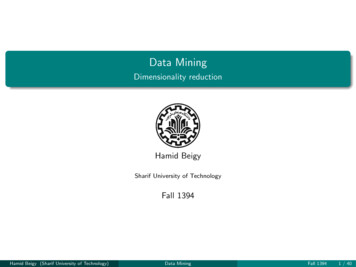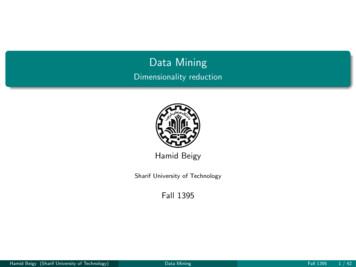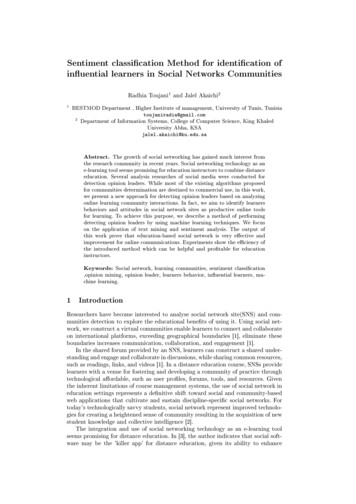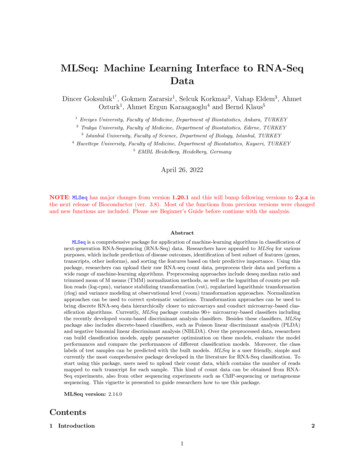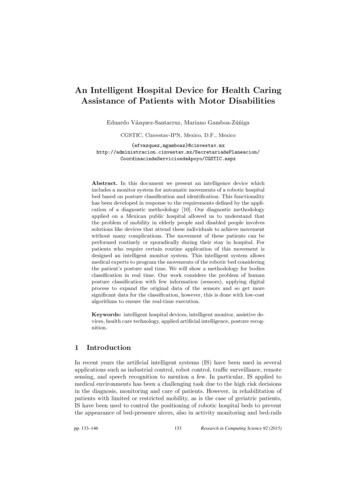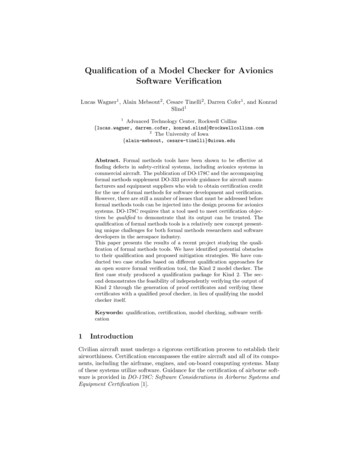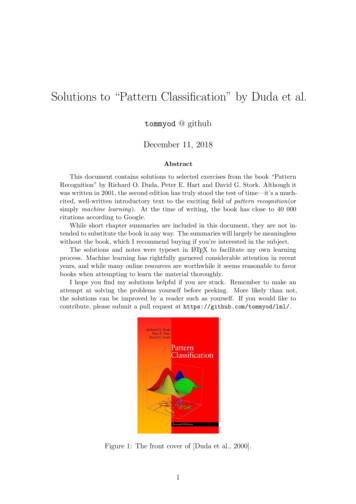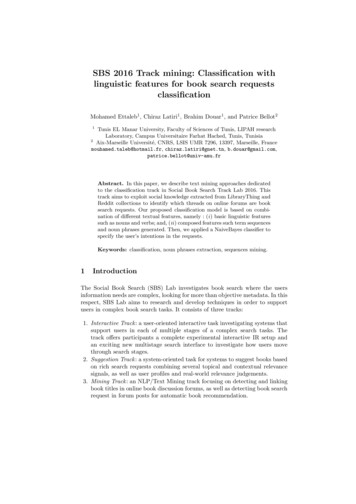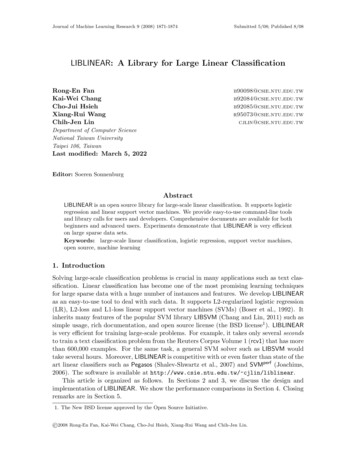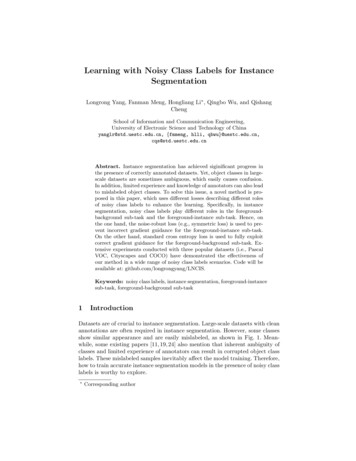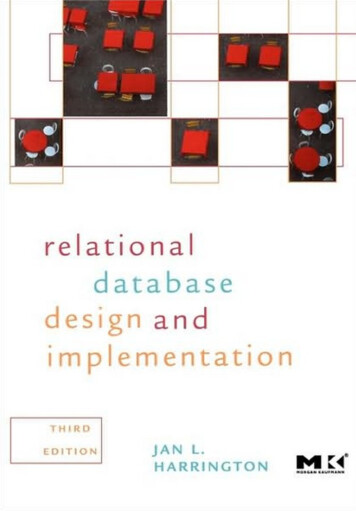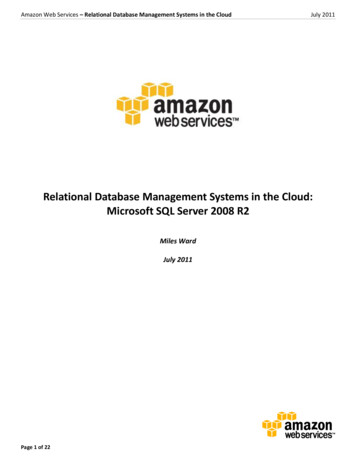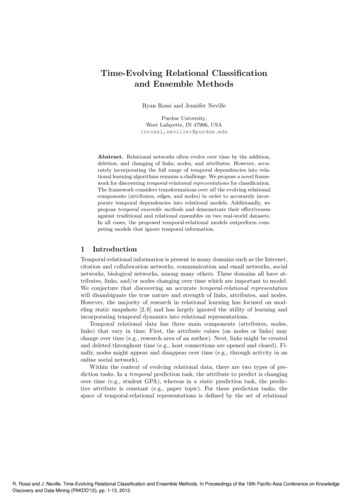
Transcription
Time-Evolving Relational Classificationand Ensemble MethodsRyan Rossi and Jennifer NevillePurdue University,West Lafayette, IN 47906, USA{rrossi,neville}@purdue.eduAbstract. Relational networks often evolve over time by the addition,deletion, and changing of links, nodes, and attributes. However, accurately incorporating the full range of temporal dependencies into relational learning algorithms remains a challenge. We propose a novel framework for discovering temporal-relational representations for classification.The framework considers transformations over all the evolving relationalcomponents (attributes, edges, and nodes) in order to accurately incorporate temporal dependencies into relational models. Additionally, wepropose temporal ensemble methods and demonstrate their e ectivenessagainst traditional and relational ensembles on two real-world datasets.In all cases, the proposed temporal-relational models outperform competing models that ignore temporal information.1IntroductionTemporal-relational information is present in many domains such as the Internet,citation and collaboration networks, communication and email networks, socialnetworks, biological networks, among many others. These domains all have attributes, links, and/or nodes changing over time which are important to model.We conjecture that discovering an accurate temporal-relational representationwill disambiguate the true nature and strength of links, attributes, and nodes.However, the majority of research in relational learning has focused on modeling static snapshots [2, 6] and has largely ignored the utility of learning andincorporating temporal dynamics into relational representations.Temporal relational data has three main components (attributes, nodes,links) that vary in time. First, the attribute values (on nodes or links) maychange over time (e.g., research area of an author). Next, links might be createdand deleted throughout time (e.g., host connections are opened and closed). Finally, nodes might appear and disappear over time (e.g., through activity in anonline social network).Within the context of evolving relational data, there are two types of prediction tasks. In a temporal prediction task, the attribute to predict is changingover time (e.g., student GPA), whereas in a static prediction task, the predictive attribute is constant (e.g., paper topic). For these prediction tasks, thespace of temporal-relational representations is defined by the set of relationalR. Rossi and J. Neville. Time-Evolving Relational Classification and Ensemble Methods. In Proceedings of the 16th Pacific-Asia Conference on KnowledgeDiscovery and Data Mining (PAKDD'12), pp. 1-13, 2012.
2R. Rossi and J. Nevilleelements that change over time (attributes, links, and nodes). To incorporatetemporal information in a representation that is appropriate for relational models, we consider two transformations based on temporal weighting and temporalgranularity. Temporal weighting aims to represent the temporal influence of thelinks, attributes and nodes by decaying the weights of each with respect to time,whereas the choice of temporal granularity restricts attention to links, attributes,and nodes within a particular window of time. The optimal temporal-relationalrepresentation and the corresponding temporal classifier depends on the particular temporal dynamics of the links, attributes, and nodes present in the data,as well as the network domain (e.g., social vs. biological networks).In this work, we address the problem of selecting the most optimal temporalrelational representation to increase the accuracy of predictive models. We consider the full space of temporal-relational representations and propose (1) atemporal-relational classification framework, and (2) a set of temporal ensemblemethods, to leverage time-varying links, attributes, and nodes in relational networks. We illustrate the di erent types of models on a variety of classificationtasks and evaluate each under various conditions. The results demonstrate theflexibility and e ectiveness of the temporal-relational framework for classification in time-evolving relational domains. Furthermore, the framework provides afoundation for automatically searching over temporal-relational representationsto increase the accuracy of predictive models.2Related WorkRecent work has started to model network dynamics in order to better predict link and structure formation over time [10, 7], but this work focuses onunattributed graphs. Previous work in relational learning on attributed graphseither uses static network snapshots or significantly limits the amount of temporal information incorporated into the models. Sharan et al. [18] assumes astrict representation that only uses kernel estimation for link weights, while GATVRC [9] uses a genetic algorithm to learn the link weights. SRPTs [11] incorporate temporal and spatial information in the relational attributes. However,the above approaches focus only on one specific temporal pattern and do notconsider di erent temporal granularities. In contrast, we explore a larger spaceof temporal-relational representations in a flexible framework that can capturetemporal dependencies over links, attributes, and nodes.To the best of our knowledge, we are the first to propose and investigatetemporal-relational ensemble methods for time-varying relational classification.However, there has been recent work on relational ensemble methods [14, 15,8] and non-relational ensemble methods for evolving streams [1]. Preisach etal. [14] use voting and stacking methods to combine relational data with multiplerelations. In contrast, Eldardiry and Neville [8] incorporates prediction averagingin the collective inference process to reduce both learning and inference variance.3Temporal-Relational Classification FrameworkBelow we outline a temporal-relational classification framework for predictiontasks in dynamic relational networks. Relational data is represented as an at-
Time-Evolving Relational Classification and Ensemble Methods3tributed graph D (G, X) where the graph G (V, E) represents a set of Nnodes, such that vi 2 V corresponds to node i and each edge eij 2 E correspondsto a link (e.g., email) between nodes i and j. The attribute set: VX [X 1 , X 2 , ., X mv ],X XE [X mv 1 , X mv 2 , ., X mv me ]contains mv observed attributes on the nodes (XV ) and me observed attributeson the edges (XE ). Dynamic relational data evolves over time by the addition,deletion, and changing of nodes, edges, and attributes. Let Dt (Gt , Xt ) referto the dataset at time t, where Gt (V, Et ) and Xt (XVt , XEt ). In our classification framework, we consider relational data observed over a range of timestepst {1, ., T } (e.g., citations over a period of years, emails over a period of days).Given this time-varying relational data, the task is to learn a model to predicteither a static attribute Y or a dynamic attribute at a particular timestep Yt ,while exploiting both the relational and temporal dependencies in the data.We define our temporal-relational classification framework with respect toa set of possible transformations of links, attributes, or nodes (as a functionof time). The temporal weighting (e.g., exponential decay of past information)and temporal granularity (e.g., window of timesteps) of the links, attributes andnodes form the basis for any arbitrary transformation with respect to the temporal information (See Table 1). The discovered temporal-relational representationcan be applied for mining temporal patterns, classification, and as a means forconstructing temporal-ensembles. An overview of the temporal-relational representation discovery is provided below:Table 1. Temporal-Relational rm WeightingTimestep1. For each Relational ComponentLinks, Attributes, or Nodes2. Select the Temporal Granularity? Timestep ti? Window {tj , tj 1 , ., ti }? Union T {t0 , ., tn }3. Select the Temporal Influence? Weighted? UniformRepeat steps 1-3 for each component.4. Select the Relational Classifier? Relational Bayes Classifier (RBC)? Relational Probability Trees (RPT)EdgesAttributesNodesTable 1 provides an intuitive view of the possible temporal-relational representations. For instance, the TVRC model is a special case of the proposedframework where the links, attributes, and nodes are unioned and the links areweighted. Below we provide more detail on steps 2-4.3.1Temporal GranularityTraditionally, relational classifiers have attempted to use all the data available ina network [18]. However, since the relevance of data may change over time (e.g.,
4R. Rossi and J. Nevillelinks become stale), learning the appropriate temporal granularity (i.e., range oftimesteps) can improve classification accuracy. We briefly define three generalclasses for varying the temporal granularity of the links, attributes, and nodes.1. Timestep. The timestep models only use a single timestep ti for learning.2. Window. The window models use a sliding window of (multiple) timesteps{tj , tj 1 , ., ti } for learning. When the size of window is varied, the space ofpossible models in this category is by far the largest.3. Union. The union model uses all previous temporal information for learningat time ti , i.e., T {0, ., ti }.The timestep and union models are separated into distinct classes for clarity inevaluation and for understandability in pattern mining.3.2Temporal Influence: Links, Attributes, NodesWe model the influence of relational components over time using temporalweighting. Specifically, when considering a temporal dataset Dt (Gt , Xt ), weXwill construct a weighted network Gt (V, Et , WtE ) and Xt (XVt , XEt , Wt ).Here Wt refers to a function that assigns weights on the edges and attributesthat are used in the classifiers below.Initially, we define WtE (i, j) 1 if eij 2 Et and 0 otherwise. Similarly, wemmmdefine WtX (xmi ) 1 if Xi xi 2 Xt and 0 otherwise. Then we consider twodi erent approaches to revise these initial weights:1. Weighting. These temporal weights can be viewed as probabilities that arelational component is still active at the current time step t, given thatit was observed at time (t k). We investigated three temporal weightingfunctions:– Exponential Kernel. The exponential kernel weights the recent past highlyand decays the weight rapidly as time passes [3]. The kernel function KEfor temporal data is defined as: KE (Di ; t, ) (1 )t i Wi– Linear Kernel. The linear kernel decays more grdually and retains thehistorical information longer: KL (Di ; t, ) Wi ( tt ttoi 1 1 )– Inverse Linear Kernel. This kernel lies between the exponential and linear kernels when moderating historical information:KIL (Di ; t, ) Wi ( ti t1o 1 )2. Uniform. These weights ignore the temporal influence of a relational component, and weight them uniformly over time, i.e., WtE (i, j) 1 if eij 2Et0 : t0 2 T and 0 otherwise. A relational component can be assigned uniform weights within the selected temporal granularity or over the entire timewindow (e.g., traditional classifiers assign uniform weights, but they don’tselect the appropriate temporal granularity).We note that di erent weighting functions can be chosen for di erent relationalcomponents (edges, attributes, nodes) with varying temporal granularities. Forinstance, the temporal influence of the links might be predicted using the exponential kernel while the attributes are uniformly weighted but have a di erenttemporal granularity than the links.
Time-Evolving Relational Classification and Ensemble Methods5(a) Graph and attribute weighting(b) Incorporating link weights(c) Using link & attribute weightsFig. 1. (a) Temporally weighting the attributes and links. (b) The feature calculation that includes only the temporal link weights. (c) The feature calculation thatincorporates both the temporal attribute weights and the temporal link weights.3.3Temporal-Relational ClassifiersOnce the temporal granularity and temporal weighting are selected for each relational component, then a temporal-relational classifier can learned. In this work,we use modified versions of the RBC [13] and RPT [12] to model the transformedtemporal-relational representation. However, we note that any relational modelthat can be modified to incorporate node, link, and attribute weights is suitablefor this phase. We extended RBCs and RPTs since they are interpretable, diverse, simple, and efficient. We use k-fold x-validation to learn the “best” model.Both classifiers are extended for learning and prediction over time.Weighted Relational Bayes Classifier. RBCs extend naive Bayes classifiers [5] to relational settings by treating heterogeneous relational subgraphsas a homogeneous set of attribute multisets. The weighted RBC uses standardmaximum likelihood learning. More specifically, the sufficient statistics for eachconditional probability distribution are computed as weighted sums of countsbased on the link and attribute weights. More formally, for a class label C, attributes X, and related items R, the RBC calculates the probability of C for anitem i of type G(i) as follows:YYYiP (C i X, R) /P (Xm C)P (Xkj C)P (C)Xm 2XG(i)j2R Xk 2XG(j)Weighted Relational Probability Trees. RPTs extend standard probability estimation trees to a relational setting. We use the standard learning algo-
6R. Rossi and J. Nevillerithm [12] except that the aggregate functions are computed after the appropriate links and attributes weights are included for the selected temporal granularity(shown in Figure 1). For prediction, if the model is applied to predict attribute Ytat time t, we first calculate the weighted data Dt . Then the learned model fromtime (t 1) is applied to Dt . The weighted classifier is appropriately augmentedto incorporate the weights from Dt .4Temporal Ensemble MethodsEnsemble methods have traditionally been used to improve predictions by considering a weighted vote from a set of classifiers [4]. We propose temporal ensemble methods that exploit the temporal dimension of relational data to constructmore accurate predictors. This is in contrast to traditional ensembles that donot explicitly use the temporal information. The temporal-relational classification framework and in particular the temporal-relational representations of thetime-varying links, nodes, and attributes form the basis of the temporal ensembles (i.e., as a wrapper over the framework). The proposed temporal ensembletechniques are drawn from one of the five methodologies described below.1. Transforming the Temporal Nodes and Links: The first method learnsan ensemble of classifiers, where each of the classifiers are learned from, andthen applied to, link and node sets that are sampled from each discretetimestep according to some probability. This sampling strategy is performedafter selecting a temporal weighting and temporal granularity, and transforming the data to the appropriate temporal-relational representation. Wenote that the sampling probabilities for each timestep can be modified tobias the sampling toward the present or the past.2. Sampling or Transforming the Temporal Feature Space: The secondmethod transforms the temporal feature space by localizing randomization(for attributes at each timestep), weighting, or by varying the temporal granularity of the features, and then learning an ensemble of classifiers with different feature sets. Additionally, we might use only one temporal weightingfunction but learn models with di erent decay parameters or resample fromthe temporal features.3. Adding Noise or Randomness: The third method is based on addingnoise along the temporal dimension of the data, to increase generalizationand performance. Specifically, we randomly permute the nodes feature valuesacross the timesteps (i.e., a nodes recent behavior is observed in the past andvice versa) or links between nodes are permuted across time, and then learnan ensemble of models from several versions of the data.4. Transforming the Time-Varying Class Labels: The fourth method introduces variance in the data by randomly permuting the previously learnedlabels at t-1 (or more distant) with the true labels at t, again learning anensemble of models from several versions of the data.5. Multiple Classification Algorithms and Weightings: The fifth methodconstructs and ensemble by randomly selecting from a set of classification
Time-Evolving Relational Classification and Ensemble Methods7algorithms (i.e., RPT, RBC, wvRN, RDN), while using the same temporalrelational representation, or by varying the representation with respect tothe temporal weighting or granularity. Notably, an ensemble that uses bothRPT and RBC models significantly increases accuracy, most likely due tothe diversity of these temporal classifiers (i.e., correctly predicting di erentinstances). Additionally, the temporal-classifiers might be assigned weightsbased on assessment of accuracy from cross-validation (or a Bayesian modelselection approach).5MethodologyFor evaluating the framework, we use both static (Y is constant over time) andtemporal prediction tasks (Yt changes over time).5.1DatasetsPyComm Developer Communication Network. We analyze email andbug communication networks extracted from the python-dev mailing list archive(www.python.org) for the period 01/01/07 09/30/08. The network consists of13181 email messages, among 1914 users. Bug reports were also extracted andused to construct a bug discussion network consisting of 69435 bug commentsamong 5108 users. The size of the timesteps are three months. We also extracted text from emails and bug messages and use it to dynamically modeltopics between individuals and teams. Additionally, we discover temporal centrality attributes (i.e., clustering coefficient, betweenness). The prediction taskis whether a developer is e ective (i.e., if a user closed a bug in that timestep).Cora Citation Network. The Cora dataset contains authorship and citationinformation about CS research papers extracted automatically from the web.The prediction tasks are to predict one of seven machine learning papers and topredict AI papers given the topic of its references. In addition, these techniquesare evaluated using the most prevalent topics its authors are working on throughcollaborations with other authors.5.2Temporal ModelsThe space of temporal-relational models are evaluated using a representativesample of classifiers with varying temporal weightings and granularities. For every timestep t, we learn a model on Dt (i.e., some set of timesteps) and applythe model to Dt 1 . The utility of the temporal-relational classifiers and representation are measured using the area under the ROC curve (AUC). Below, webriefly describe a few classes of models that were evaluated.– TENC: The TENC models predict the temporal influence of both the linksand attributes [16].– TVRC: This model weights only the links using all previous timesteps.– Union Model: The union model uses all links and nodes up to and includingt for learning.
8R. Rossi and J. Neville– Window Model: The window model uses the data Dt 1 for prediction onDt (unless otherwise specified).We also compare simpler models such as the RPT (relational informationonly) and the DT (non-relational) that ignore any temporal information. Additionally, we explore many other models, including the class of window models,various weighting functions (besides exponential kernel), and built models thatvary the set of windows in TENC and TVRC.6Empirical ResultsIn this section, we demonstrate the e ectiveness of the temporal-relational framework and temporal ensemble methods on two real-world datasets. The mainfindings are summarized below:? Temporal-relational models significantly outperform relational and nonrelational models.? The classes of temporal-relational models each have advantages and disadvantages in terms of accuracy, efficiency, and interpretability. Models basedstrictly on temporal granularity are more interpretable but less accurate thanmodels that learn the temporal influence. The more complex models thatcombine both are generally more accurate, but less efficient.? Temporal ensemble methods significantly outperform non-relational and relational ensembles. In addition, the temporal ensembles are an efficient andaccurate alternative to searching over the space of temporal models.6.1Single Models1.001TVRC0.960.920.94AUC0.98We evaluate the temporal-relational frameRPTIntrinsicwork using single-models and show that inInt timeInt graphall cases the performance of classification imInt topicsproves when the temporal dynamics are appropriately modeled.Temporal, Relational, and NonRelational Information. The utility of thetemporal (TVRC), relational (RPT), andnon-relational information (decision tree;DT) is assessed using the most primitivemodels. Figure 2 compares TVRC with the Fig. 2. Comparing a primitive temRPT and DT models that use more fea- poral model (TVRC) to compettures but ignore the temporal dynamics of ing relational (RPT), and nonrelational (DT) models.the data. We find the TVRC to be the simplest temporal-relational classifier that still outperforms the others. Interestingly,the discovered topic features are the only additional features that improve performance of the DT model. This is significant as these attributes are discoveredby dynamically modeling the topics, but are included in the DT model as simplenon-relational features (i.e., no temporal weighting or granularity).1For brevity, some plots and comparisons were omitted [17].
Time-Evolving Relational Classification and Ensemble Methods90.800.650.700.75AUC0.850.900.95Exploring Temporal-Relational Models.We focus on exploring a representative set ofTENCTVRCTVRC Uniontemporal-relational models from the proposedWindow ModelUnion Modelframework. To more appropriately evaluatethe models, we remove highly correlated attributes (i.e., that are not necessarily temporalpatterns, or motifs), such as “assignedto” inthe PyComm prediction task. In Figure 3, wefind that TENC outperforms the other modelsover all timesteps. This class of models are significantly more complex than TVRC since thetemporal influence of both links and attributesFig. 3. Exploring the spaceare learned.of temporal relational models.We then explored learning the appropri- Significantly di erent temporalate temporal granularity. Figure 3 shows the relational representations fromresults from two models in the TVRC class the proposed framework arewhere we tease apart the superiority of TENC evaluated.(i.e., weighting or granularity). However, bothTVRC models outperform one another on di erent timesteps, indicating the necessity for a more precise temporal-representation that optimizes the temporalgranularity by selecting the appropriate decay parameters for links and attributes(i.e., TENC). Similar results were found using Cora and other base classifierssuch as RBC. Models based strictly on varying the temporal granularity werealso explored. More details can be found in [17].Temporal-Ensemble ModelsT 3T 40.96AUC0.98TVRCRPTDT0.94Instead of directly learning the optimaltemporal-relational representation to increase the accuracy of classification, we usetemporal ensembles by varying the relationalrepresentation with respect to the temporalinformation. These ensemble models reduceerror due to variance and allow us to assesswhich features are most relevant to the domain with respect to the relational or temporal information.0.926.2T 21.00T 1T 1T 2T 3T 4AvgFig. 4. Comparing temporal, relational, and traditional ensemblesTemporal, Relational, and TraditionalEnsembles. We first resampled the instances (nodes, links, features) repeatedly and then learn TVRC, RPT, and DTmodels. Across almost all the timesteps, we find the temporal-ensemble that usesvarious temporal-relational representations outperforms the relational-ensembleand the traditional ensemble (see Figure 4). The temporal-ensemble outperformsthe others even when the minimum amount of temporal information is used (e.g.,time-varying links). More sophisticated temporal-ensembles can be constructed
10R. Rossi and J. Neville0.10DTTVRCRPTAUC Drop0.080.060.04tkinter teamtopics email discussiontopics bug discussiontopics all discussionunicode teambc centrality all discussiondegree centrality all discussionbc centrality bug discussionhasclosed prevclust coeff all discussionteam countclust coeff email discussionbc centrality email discussioneigen centrality all discussionbug discussion countall communication countdegree centrality emailemail discussion countassigned count prev0.00assigned count0.02Fig. 6. Randomization. The significant attributes used in the temporal ensemble arecompared to the relational and traditional ensembles. The change in AUC is measured.0.80.60.7AUC0.91.0to further increase accuracy. We have investigated ensembles that use significantly di erent temporal-relational representations (i.e., from a wide range ofmodel classes) and ensembles that use various temporal weighting parameters.In all cases, these ensembles are more robust and increase the accuracy overmore traditional ensemble techniques (and single classifiers). Further, the averageimprovement of the temporal-ensembles is significant at p 0.05 with a 16%reduction in error, justifying the proposed temporal ensemble methodologies.In the next experiment, we constructensembles using the feature classes. WeTVRCuse the primitive models (with the transRPTDTformed feature space) in order to investigate (more accurately) the most significantfeature class (communication, team, centrality, topics) and also to identify the minimum amount of temporal information required to outperform relational ensembles.In Figure 5, we find several strikingtemporal patterns. First, the team featuresare localized in time and are not changing frequently. For instance, it is unlikelythat a developer changes their assigned Fig. 5. Comparing attribute classesw.r.t. temporal, relational, and traditeams and therefore modeling the tempotional ensembles.ral dynamics only increases accuracy bya relatively small percent. However, thetemporal-ensemble is still more accurate than traditional ensemble methodsthat ignore temporal patterns. This indicates the robustness of the temporalrelational representations. More importantly, the other classes of attributes areevolving considerably and this fact is captured by the significant improvement ofthe temporal ensemble models. Similar performance is also obtained by varyingthe temporal granularity (see previous zation. We use randomization to identify the significant attributesin the temporal-ensemble models. Randomization provides a means to rank andeliminate redundant attributes (i.e., two attributes may share the same signif-
Time-Evolving Relational Classification and Ensemble Methods11icant temporal pattern). We randomize each attribute in each timestep andmeasure the change in AUC. The results are shown in Figure 6.We find that the basic traditional ensemble relies on “assignedto” (in thecurrent time step) while the temporal ensemble (and even less for the relationalensemble) relies on the previous “assignedto” attributes. This indicates thatrelational information in the past is more useful than intrinsic information in thepresent—which points to an interesting hypothesis that a colleagues behavior(and interactions) precedes their own behavior. Organizations might use thisto predict future behavior with less information and proactively respond morequickly. Additionally, the topic attributes are shown to be the most useful for thetemporal ensembles (Fig. 7), indicating the utility of using topics to understandthe context and strength of relationships.0.900.95TENCTVRCWindow ModelUnion Model0.85AUCTopic udehomefilerunmainlocalsrcdirectory0.80Topic 0.75Topic c ic plemakepmvesupportmodulethingsgoodvanT 1T 2T 3T 4AVGFig. 7. Evaluation of temporal-relational classifiers using only the latent topics of thecommunications to predict e ectiveness. LDA is used to automatically discover thelatent topics as well as annotating the communication links and individuals with theirappropriate topic in the temporal networks.7ConclusionWe proposed and validated a framework for temporal-relational classifiers, ensembles, and more generally, representations for temporal-relational data. Weevaluated an illustrative set of temporal-relational models from the proposedframework. Empirical results show that the models significantly outperformcompeting classification models that use either no temporal information or avery limited amount. The proposed temporal ensemble methods (i.e., temporallysampling, randomizing, and transforming features) were shown to significantlyoutperform traditional and relational ensembles. Furthermore, the temporalensemble methods were shown to increase the accuracy over traditional models while providing an efficient alternative to exploring the space of temporalmodels. The results demonstrated the e ectiveness, scalability, and flexibility of
12R. Rossi and J. Nevillethe temporal-relational representations for classification and ensembles in timeevolving domains. In future work, we will theoretically analyze the frameworkand the proposed ensemble methods.AcknowledgmentsThis research is supported by NSF under contract number SES-0823313 and by theDepartment of Defense thro
and Ensemble Methods Ryan Rossi and Jennifer Neville Purdue University, West Lafayette, IN 47906, USA {rrossi,neville}@purdue.edu Abstract. Relational networks often evolve over time by the addition, . In Proceedings of the 16th Pacific-Asia Conference on Knowledge Discovery and Data Mining (PAKDD'12), pp. 1-13, 2012. 2R.RossiandJ.Neville.
